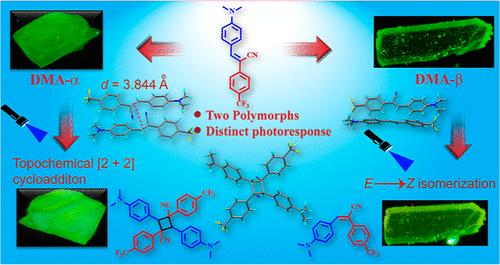Tunable Photoresponsive Behavior of Organic Materials by Polymorphic Variation: Topochemical [2 + 2] Cycloaddition vs E–Z Isomerization
IF 3.4
2区 化学
Q2 CHEMISTRY, MULTIDISCIPLINARY
引用次数: 0
Abstract
Molecular crystals that can display stimuli-responsive behavior are a fascinating class of materials that can be used in various advanced technologies. However, designing and developing molecular crystal polymorphs that could respond differently to a single stimulus are still a challenging task. In this article, we report remarkably different photoresponses of the two polymorphs (DMA-α and DMA-β) of a simple donor–acceptor-type organic molecule (E)-3(4-(dimethylamino)phenyl)-2(4-(trifluoromethyl)phenyl)acrylonitrile (DMA). Upon 456 nm light irradiation, DMA-α crystals undergo topochemical [2 + 2] cycloaddition reaction due to favorable stacking of C═C double bonds in the crystal lattice, while DMA-β crystals exhibit E- to Z-isomerization reaction. Furthermore, the emission maxima (λmax,em) of both crystals shifted differently due to photoreaction. The origin of the distinct photoreactivities of two polymorphs could be rooted to different molecular packing and intermolecular interactions in the respective crystal lattices. Our work provides an effective strategy to tune the photoreactivity of organic crystalline materials and their potential applications in sensors, actuators, and other optoelectronic devices.

通过多态性变化调控有机材料的光致伸缩行为:Topochemical [2 + 2] Cycloaddition vs E-Z Isomerization
能够显示刺激响应行为的分子晶体是一类迷人的材料,可用于各种先进技术。然而,设计和开发能对单一刺激做出不同反应的分子晶体多晶体仍然是一项具有挑战性的任务。在本文中,我们报告了一种简单的供体-受体型有机分子 (E)-3(4-(dimethylamino)phenyl)-2(4-(trifluoromethyl)phenyl)acrylonitrile (DMA)) 的两种多晶体(DMA-α 和 DMA-β)的显著不同的光响应。在 456 纳米光照射下,由于晶格中 C═C 双键的有利堆积,DMA-α 晶体发生拓扑化学[2 + 2] 环加成反应,而 DMA-β 晶体则表现出 E- 到 Z-异构化反应。此外,由于光反应,两种晶体的发射最大值(λmax,em)发生了不同的移动。两种多晶体不同的光反应活性可能源于各自晶格中不同的分子堆积和分子间相互作用。我们的研究为调整有机晶体材料的光反应活性及其在传感器、致动器和其他光电器件中的潜在应用提供了一种有效的策略。
本文章由计算机程序翻译,如有差异,请以英文原文为准。
求助全文
约1分钟内获得全文
求助全文
来源期刊

Crystal Growth & Design
化学-材料科学:综合
CiteScore
6.30
自引率
10.50%
发文量
650
审稿时长
1.9 months
期刊介绍:
The aim of Crystal Growth & Design is to stimulate crossfertilization of knowledge among scientists and engineers working in the fields of crystal growth, crystal engineering, and the industrial application of crystalline materials.
Crystal Growth & Design publishes theoretical and experimental studies of the physical, chemical, and biological phenomena and processes related to the design, growth, and application of crystalline materials. Synergistic approaches originating from different disciplines and technologies and integrating the fields of crystal growth, crystal engineering, intermolecular interactions, and industrial application are encouraged.
 求助内容:
求助内容: 应助结果提醒方式:
应助结果提醒方式:


